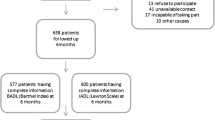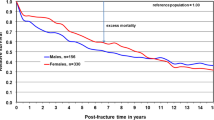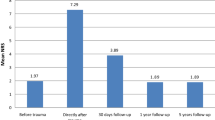Abstract
The purpose of this study was to evaluate in aged patients with hip fracture, the degree of recovery at discharge and after discharge relative to the pre-fracture walking level, to clarify the factors involved in unsuccessful recovery. The patients were 189 patients aged 60 years and older who underwent surgery between 1988 and 1994. Patients who died within 1 year or lacked data on walking were excluded. Multiple logistic regression analysis was applied to data on the walking level before fracture, that at discharge, and the best walking level after discharge, to clarify factors involved in unsuccessful recovery. The rate of recovery to the pre-fracture level was 55.1% at discharge. Unsuccessful recovery at discharge was influenced by prior dementia, a history of cerebrovascular diseases, and an age of 85 or more years. Analysis showed an “after-discharge” recovery rate of 63.2%. Prior dementia and the residence outside one’s own home influenced unsuccessful recovery rate.
These findings suggested that it is important to provide patients with such factors a more effective postoperative rehabilitation program not merely the standard rehabilitation program. In addition, a walking rehabilitation program should be offered to those who were re-hospitalized or admitted to other health care facilities.
Similar content being viewed by others
References
Orimo H, Hashimoto T, Shiroki M, Hukunaga M, Fujiwara S, Nakamura T, et al. The Epidemiology of osteoporosis in Japan. Jpn. Med. 1995; 370: 27–30.
Jette AM, Harris BA, Cleary PD, Campion EW. Functional recovery after hip fracture. Arch. Phys. Med. Rehabil. 1987; 68: 735–740.
DePlma L, Rizzi L, Lorini G, Greco F. Survival after Trochanteric fracture. Acta Orthop. Scand. 1992; 63: 645–647.
Fawnworth MG, Kenny P, Shiel A. The cost and effects of early discharge in the management of fractured hip. Age Aging 1994; 23: 180–194.
Zuckerman JD. Current concepts. New Eng. J. Med. 1996; 334: 1519–1525.
Barnes B. Ambulation outcomes after hip fracture. Phys. Ther. 1984; 64: 317–321.
Walheim G, Barrios C, Stark A, Brostrom LA, Olsson E. Postoperative improvement of walking capacity in patients with trochanteric hip fracture. J. Orthop. Trauma. 1990; 4: 137–143.
Koval KJ, Skovron ML, Aharonoff GB, Meadows SE, Zuckerman JD. Ambulatory ability after Hip fracture. Clin. Orthop. 1995; 310: 150–159.
Nagata O, You K, Yokoyama H, Tateishi H, Sonoo S. A study of preoperative evaluation of laboratory data and prognosis in elderly patients with femoral neck fracture. Cen. JPN J. Orthop. Surg. Traum. 1994; 37: 1459–1460.
Tushima E, Oda A, Morinaga K, Factors which influence the decline of daily living in patients with hip fracture. Annual report of the Touhoku section of Japanese physical therapy association 1995; 7: 11–15.
Takeshita H, Imai R, Miyamoto T, Houzyou T, Nakazima S. Walking ability and prognosis after treatment of the femoral neck fracture. Cen. JPN J. Orthop. Surg. Traum. 1995; 38: 339–340.
Kitamura S, Hasegawa Y, Suzuki S, Sasaki R, Iwata H, Hans W, et al. Functional outcome after hip fracture in Japan. Clin. Orthop. 1998; 348: 29–36.
Kishi S, Kawashima S, Kataoka Y, Iwata H, Muramatu T, Watabe K. The study of general condition and function prognosis in the treatment of senile femoral neck fracture. Orth. Surg. 1986;37: 1877–1881.
Kenzora JE, McCarthy RE, Lowell JD, Sledge CB. Hip fracture mortality. Clin. Orthop. 1984; 186: 45–56.
Fuyuki H. Considerations in post-operative exercise for patients with femoral and trochanteric fracture. Sogo rehabilitation 1998; 26: 635–640.
Okamoto R. Pre- and postoperative rehabilitation of the lower extremity-hip aid knee. Sogo rehabilitation 1993; 21: 573–578.
Jay Magaziner, Eleanor M, Simonsick T, Kashner TM, Hebel JR, Kenzora JE. Functional recovery one year following hospital discharge for hip fracture A Prospective Study. Journal of Gerontology. Medical Sciences 1990; 45: 101–107.
Ceder L, Thorgren KG, Wallden B. Prognosis indicators and early home rehabilitation in elderly patients with hip fracture. Clin. Orthop. 1980; 152: 173–184.
Hamajima N. Clinical studies by multivariate analysis—Introduction to proportional hazard model and Logistic model with application programs of SAS. 2nd Ed. The university of Nagoya press. 1993.
Tango T, Yamaoka K, Takagi H. Logistic regression analysis. Asakura book. 1996.
Nakamura T. Epidemiological study on hip fractures in Tottori prefecture. J. Jpn. Orthop. Assoc. 1993; 67: 189–200.
Doumae Y, Takahashi H, Kawashima T, Tanizawa T, Nishida S. Epidemiology of femoral neck fracture in 1989. JBMM 1991; 9: 94–98.
Mossey JM, Mutran E, Knott K, Craik R. Determinants of recovery 12 months after hip fracture. The important of psychosocial factors. Am. J. Pub. Health 1989; 79: 279–286.
Magaziner J, Simonsick EM, Kasshner TM, Hebel JR. Patients-proxy response comparability on measures of patients health and functional status. J. Clin. Epidemiol. 1988; 41: 1065–1074.
Health and Welfare Statistics Association. Journal of Health and Welfare Statistics (Kokumin Eisei No Doko 1998). Tokyo: Health and Welfare Statistic Association, 1998.
Author information
Authors and Affiliations
Rights and permissions
About this article
Cite this article
Takayama, S., Iki, M., Kusaka, Y. et al. Factors that influence functional prognosis in elderly patients with hip fracture. Environ Health Prev Med 6, 47–53 (2001). https://doi.org/10.1007/BF02897309
Received:
Accepted:
Issue Date:
DOI: https://doi.org/10.1007/BF02897309




